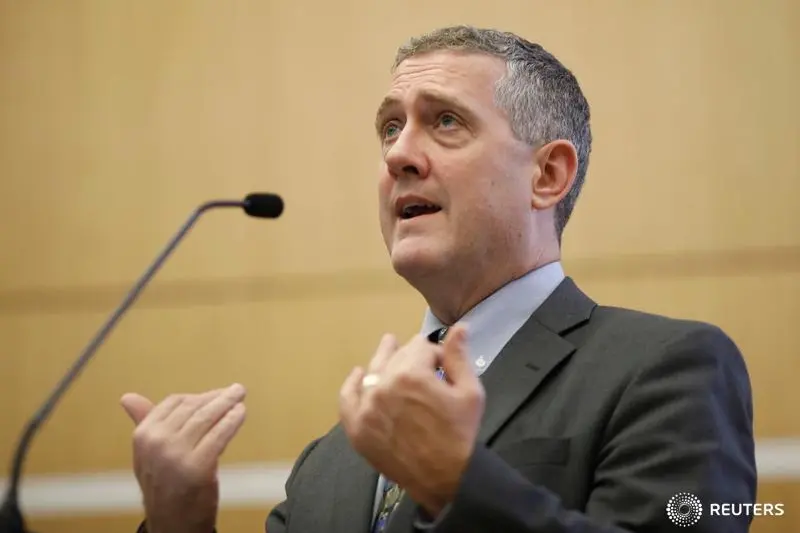PHOTO
WASHINGTON- The Federal Reserve should let its roughly $8 trillion balance sheet shrink next year as soon as it winds down a bond purchase program, St. Louis Federal Reserve president James Bullard said, cautioning high inflation may require more aggressive steps by the central bank including two interest rate hikes in 2022.
In an interview Bullard said he now expects inflation to remain at 2.8% through next year, well above the central bank's 2% target and the highest among new economic projections issued by Fed officials last week.
While Bullard said he agrees inflation will ease somewhat on its own, he said it will take more central bank effort to ensure that happens smoothly over time, and never requires the sort of restrictive policies that could imperil the current expansion.
Inflation "is going to stay above target over the forecast horizon. That is a good thing. We are delivering on our...framework," Bullard said of Fed projections last week that inflation will remain above 2% through 2024, even as interest rates remain below the level that would be considered restrictive.
HIGH BUT HOW HIGH
A new Fed framework seeks a period of higher inflation to offset weak inflation over the last decade. Still, the jump in inflation this year has surprised officials and now appears likely to last longer than first expected. At their meeting last week policymakers did pencil in slightly higher rates beginning next year, the start of a possible hedge against prices rising too fast.
"There is now a risk we are going to overachieve and be too high for too long...How much of that do we want...That is the key question for the (Federal Open Market) Committee over the next year.”
That discussion is central to the evolution of the post pandemic economy with implications for the U.S. job market and the fate of some of the Biden administration's core policy ideas. And it will mark a closing chapter of sorts on the programs the Fed put in place to fight the pandemic.
The Fed has largely agreed on an end to one of those programs, its $120 billion in bond purchases, with a plan to phase them out starting later this year and end them altogether in the first months of 2022. The pace and start date of the bond "taper" remain under discussion, with an announcement likely at the Fed's November meeting hinging partly on upcoming jobs and other data.
Bullard said it would likely take a "very large shock" to throw that process off course.
As a consequence policymakers are now gradually turning to their next, and arguably more consequential, discussions -- when to raise interest rates and what to do with the stockpile of Treasury securities and mortgage backed securities the Fed accumulated during the fight against the pandemic.
The asset holdings will likely be around $8.5 trillion by the time the Fed stops buying new securities, and Bullard said there was no reason to hold on to them. After the 2007 to 2009 financial crisis and recession, the Fed continued buying bonds for roughly five years. It took three years more, until 2017, before it stopped reinvesting the proceeds of maturing assets and let its balance sheet decline.
"Everything can occur much faster than it could have in the previous recovery," Bullard said, noting that U.S. economic output had already surpassed its pre-pandemic level.
"We should start to allow runoff of the balance sheet...We could get going on that process at the end of the taper" next year, he said. "That would be a natural time to do it...It looks like a robust expansion all the way through next year. We are going to be in great shape at that point."
Fed policymakers have not begun those discussions, he said, but "I don't think it is too early" given the surprising speed of the recovery and the continued concern about inflation.
If the Fed's holdings of longer-term securities begins to fall, it would in theory lead to higher long-term interest rates. In that sense it would work alongside increases in the Fed's short-term policy interest rate to reduce central bank support for the economy overall.
POLICY REMAINS LOOSE
Recent Fed projections never see central bank policy actually becoming restrictive in the years ahead. The median projected federal funds rate reaches just 1.8% in 2024, still short of the long-run rate of 2.5% that would be considered roughly "neutral."
Bullard himself sees rates reaching a slightly higher 2% over time, but even that, he noted, is right at his own estimate of neutral.
But his outlook for a faster pace of rate hikes, beginning with two increases next year, reflects a concern that the combination of a global supply shock and loose Fed policy make prime conditions for faster and more persistent inflation than foreseen by other policymakers convinced the pace of price increases remains anchored low.
It may all work out "and we will converge into bliss at the steady state where inflation is at 2% and we never change the funds rate again," he said. "That is the current scenario...We all know reality will probably be something messier."
For the many among his colleagues who downplay inflation risk and say the Fed should keep rates lower to encourage more job growth, he said: "I am not trying to prejudge where we will be next spring. It could easily be the case that inflation could fall back to target and it will be all beautiful the way we have described it.
"Inflation could also be a lot more persistent than we had hoped and in that case we will have to recalibrate how we are going to keep inflation under control.”
Howard Schneider
(Reporting by Howard Schneider Editing by Chizu Nomiyama) ((howard.schneider@thomsonreuters.com; +1 202 789 8010;))












